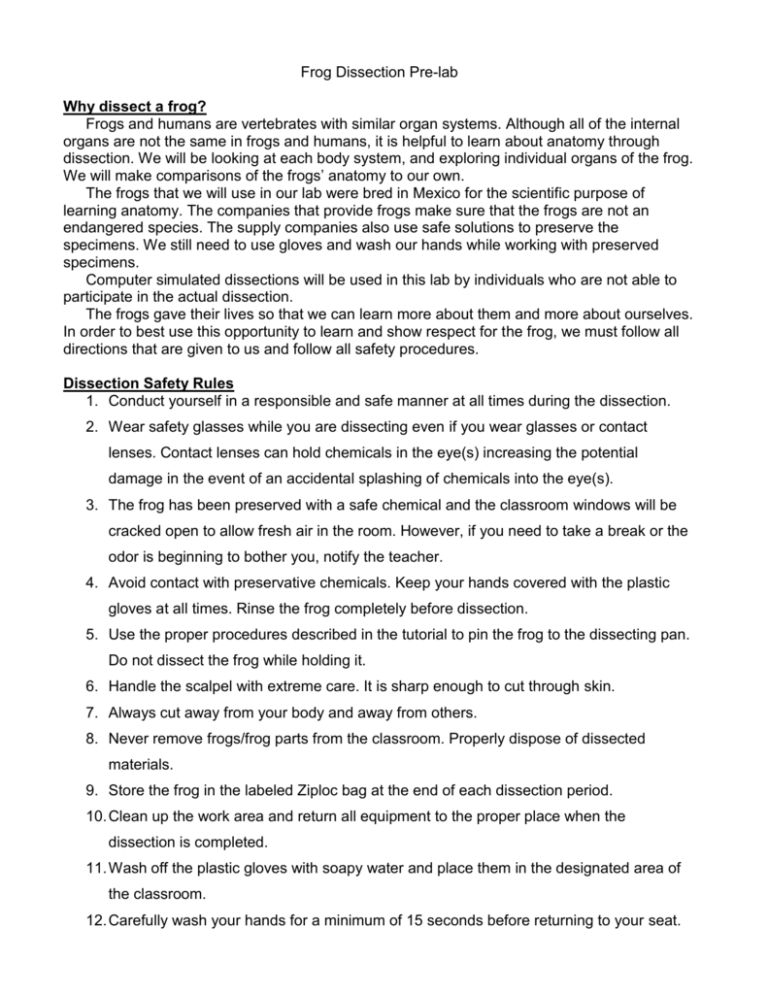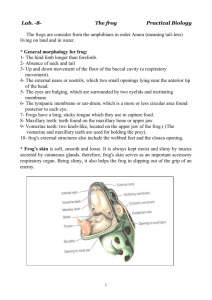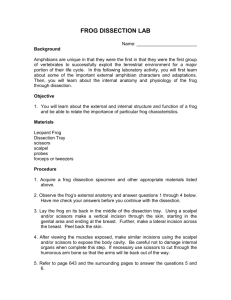Frog Dissection Pre-lab
advertisement

Frog Dissection Pre-lab Why dissect a frog? Frogs and humans are vertebrates with similar organ systems. Although all of the internal organs are not the same in frogs and humans, it is helpful to learn about anatomy through dissection. We will be looking at each body system, and exploring individual organs of the frog. We will make comparisons of the frogs’ anatomy to our own. The frogs that we will use in our lab were bred in Mexico for the scientific purpose of learning anatomy. The companies that provide frogs make sure that the frogs are not an endangered species. The supply companies also use safe solutions to preserve the specimens. We still need to use gloves and wash our hands while working with preserved specimens. Computer simulated dissections will be used in this lab by individuals who are not able to participate in the actual dissection. The frogs gave their lives so that we can learn more about them and more about ourselves. In order to best use this opportunity to learn and show respect for the frog, we must follow all directions that are given to us and follow all safety procedures. Dissection Safety Rules 1. Conduct yourself in a responsible and safe manner at all times during the dissection. 2. Wear safety glasses while you are dissecting even if you wear glasses or contact lenses. Contact lenses can hold chemicals in the eye(s) increasing the potential damage in the event of an accidental splashing of chemicals into the eye(s). 3. The frog has been preserved with a safe chemical and the classroom windows will be cracked open to allow fresh air in the room. However, if you need to take a break or the odor is beginning to bother you, notify the teacher. 4. Avoid contact with preservative chemicals. Keep your hands covered with the plastic gloves at all times. Rinse the frog completely before dissection. 5. Use the proper procedures described in the tutorial to pin the frog to the dissecting pan. Do not dissect the frog while holding it. 6. Handle the scalpel with extreme care. It is sharp enough to cut through skin. 7. Always cut away from your body and away from others. 8. Never remove frogs/frog parts from the classroom. Properly dispose of dissected materials. 9. Store the frog in the labeled Ziploc bag at the end of each dissection period. 10. Clean up the work area and return all equipment to the proper place when the dissection is completed. 11. Wash off the plastic gloves with soapy water and place them in the designated area of the classroom. 12. Carefully wash your hands for a minimum of 15 seconds before returning to your seat. Dissecting Equipment A Figure 1: Basic Dissecting Tools B C Figure 2: Dissecting Pins Figure 3: Dissecting Pan Figure 1 shows the dissection equipment you will use in this investigation. A. Teasing or Dissection needle which used to pull apart muscle tissue, B. Dissecting scissors which is used to cut through tissue, and C. Forceps, which is used to lift and move cut tissue. Figure 2 shows different types of dissecting pins. Dissecting pins are used to hold the frog in place in the dissecting tray. They are also used to hold back the skin and muscles so you can observe the internal organs. Figure 3 shows a dissecting pan. The dissecting pan holds the frog as you dissect it. You will use the dissecting pins to secure the frog to the dissecting pan. At the end of the dissection, you will remove and discard in the trashcan the tissues from the pan and then rinse the pan off with water. Pre-lab Questions Directions: Read the Frog Dissection Pre-lab Resource Sheet. Then complete the pre-lab questions. Have your parents sign this paper when you are finished. This paper must be completed and signed by you and your parents before you will be permitted to begin the frog dissection. If these questions are not complete and on time, you will not be able to participate in the lab. 1. What is the purpose of this lab? ___________________________________________ ______________________________________________________________________ ____________________________________________________________________ 2. What safety guidelines will be practiced when doing this lab? ____________________ ______________________________________________________________________ ____________________________________________________________________ ______________________________________________________________________ ____________________________________________________________________ 3. List the scientific name and purpose of the tools you will use during the dissection. Tool Purpose of Tool I give my permission for my son/daughter to participate in the firsthand dissection of the frog. ________________________________________ (Parent signature) I have read the safety guidelines and description of the dissecting equipment that I will be using during this investigation. I agree to abide by all rules. I understand that my behavior will not only affect my personal safety but the safety of all of the members of my group. _________________________________ Student Signature Pre-Lab Questions & Systems System Function Name of the system What does this system do for the frog Muscle-skeletal Circulatory Digestive Nervous Reproductive Evidence What do you expect to see in the frog as evidence of this system? Bill Nye the Science Guy: Amphibians http://www.gamequarium.org/cgi-bin/search/linfo.cgi?id=8322 Nifty questions from this episode: 1. What does the Greek word “amphibian” mean? __________________________________________________________________ 2. What does the word “metamorphosis” mean? __________________________________________________________________ 3. Do amphibians have gills to breathe, and do they live on land or in water? __________________________________________________________________ 4. What is a “baby” frog called? _____________________________________________ HOMEWORK: Frog Background Information Frogs go through several life stages before developing the organ systems that we will see in the lab. “Metamorphosis” is the term used to describe changes in life forms. Insects also go through metamorphosis. Use your textbook to learn more about amphibians. Then diagram the stages of frog metamorphosis, using color and captions to describe the stages.








